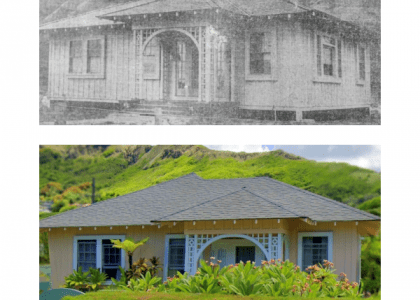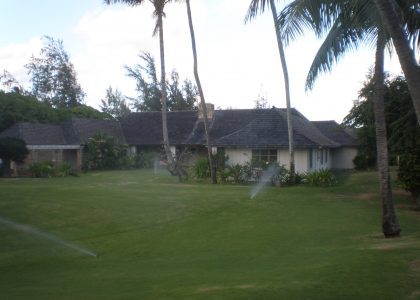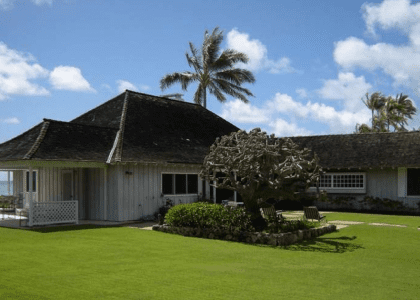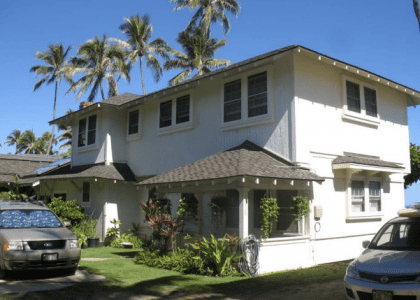

The Strode Residence, located on Lanikai Beach, is not just a house—it’s a part of Hawaii’s history. Built in 1936, this home tells the story of Dr. Joseph E. Strode and his family, as well as the neighborhood of Lanikai, as it grew into a unique beachside community. Its design shows how people in Hawaii created homes perfect for the islands’ warm climate and stunning environment.
Who Was Dr. Joseph Strode?
Dr. Joseph Emerson Strode grew up on a farm in Missouri and studied to become a doctor. In 1916, he came to Hawaii to work at Queen’s Hospital in Honolulu. He quickly became an important surgeon and helped start the Straub Clinic, one of the first medical groups in Hawaii. There, doctors with different specialties worked together to take care of patients.
Dr. Strode spent over 50 years helping people as a surgeon and training other doctors. But he wasn’t all work—he loved relaxing by the ocean, playing golf, and reading. He and his wife, Pauline, decided to build a beach house in Lanikai to enjoy weekends with their son and friends.
The Strode Residence: Building a Family Retreat
In 1936, Lanikai was a quiet area with only a few homes. It had just been developed into a neighborhood for people who wanted a peaceful getaway. Dr. Strode and Pauline purchased a lot near the beach with views of the Mokulua Islands. They hired James G. Morgan, a local architect, to design the house and Riyoichi Kawasaki, a skilled builder, to construct it.
The Strode Residence was built as a simple beach house, perfect for relaxing and enjoying the ocean. The home had features that fit Hawaii’s warm weather and connected it to the natural surroundings.
What Makes the Strode Residence Historic?
There’s a difference between being old and being historic. The Strode Residence is historic because it is an excellent example of Hawaiian Regionalist architecture, a style created to work well in Hawaii’s tropical climate. Here are some of its unique features:
- Bell-Cast Roof: The roof has two slopes, which help rain run off quickly while creating a beautiful shape.

- The Strode home has many windows to bring in natural light and cool ocean breezes.
- Bell-Cast Roof: The roof has two slopes, which help rain run off quickly while creating a beautiful shape. (See photo above)
- Lanai: The house has open porch areas that let in fresh air and connect the inside of the home to the outdoors.
- Wood Walls: The walls are made of vertical wooden planks, which are lightweight but strong.
- Big Windows: The house has many windows to bring in natural light and cool ocean breezes.
The inside of the home was designed for both fun and function. It has a large central room for family gatherings, surrounded by bedrooms for privacy. The lanai areas on both the mountain (mauka) and ocean (makai) sides made it easy to enjoy Hawaii’s exceptional views.
How the House Changed Over Time
At first, the Strode Residence was just a vacation home where the family stayed on weekends. But by 1946, they decided to make extended visits more comfortable. They expanded the house, adding space to the bedrooms. 1955, Dr. Strode retired, and the family moved into the Lanikai home full-time.
These changes were part of a more significant trend in Lanikai. Many early beach houses were being updated to become permanent homes as the area grew. Road improvements, like the Pali Highway, made traveling between Lanikai and Honolulu easier.
Dr. Strode’s Legacy in Lanikai
Dr. Strode and Pauline created a home that was more than just a place to live. It was a gathering spot for family and friends, filled with happy memories. Pauline’s family connections in Hawaii added to the importance of the home. Her father was a successful businessman who helped shape the islands’ economy. Together, the Strodes made their home a special part of the Lanikai community.
The Neighborhood: Lanikai’s History
Lanikai, which means “heavenly sea,” became a neighborhood in the 1920s. Charles R. Frazier, a businessman, developed the area, carving it out of former ranchland. With its quiet streets and beautiful beaches, Lanikai was designed to feel like a peaceful escape. Early residents built homes that blended with the natural surroundings, including many in the Hawaiian Regionalist style.
The Strode Residence fits right into this history. Its simple, open design reflects the lifestyle of people who want to enjoy the beach and the outdoors. The house has remained mostly the same over the years, keeping its original charm while adapting to the needs of its owners.
Keeping the History Alive
Today, the Strode Residence is more than just a house. It’s a piece of Hawaii’s past, showing how people lived, worked, and relaxed in the early 20th century. The current owners have worked hard to preserve the home’s original style, ensuring it remains a part of Lanikai’s story.
This house reminds us of when Lanikai was just starting to grow into the beautiful community it is today. By preserving places like the Strode Residence, we keep these stories alive for future generations.
Sources
Chapman, W. (2018). Strode House [Nomination for the Hawaii State Register of Historic Places]. DLNR Hawaii. dlnr.hawaii.gov




